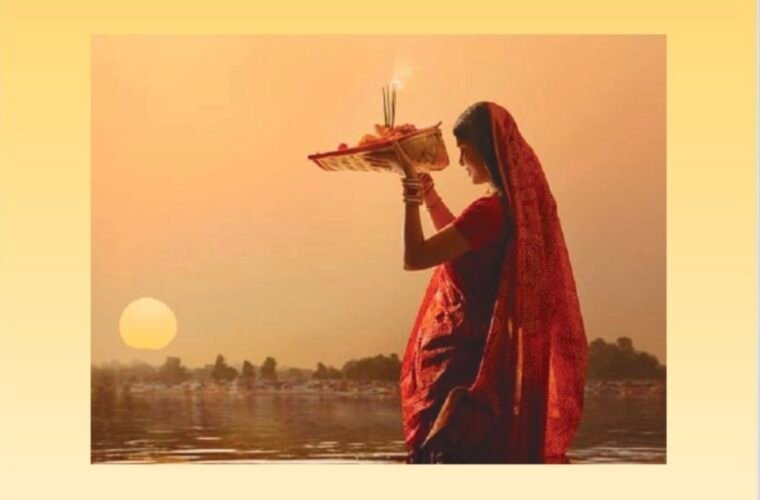Narayan Prasad Ghimire, Kathmandu, Oct 25: A book penned by a researcher Jivesh Jha on the Chhath festival has showed the ties between spiritual awakening and development. The “Beneath the Sun: Equality for Everyone, the Spirit of Chhath Festival” penned by legal scholar Jha celebrates the Chhath festival, bringing into light the social, economic, environmental and development aspects.
The Chhath festival, during which the Sun God is revered, is mainly celebrated in the Mithila region of Nepal- the eastern southern plains/Tarai- and even Bihar and eastern part of Uttar Pradesh, India is now gradually expanding to hilly regions. Even the Kathmandu Valley observes the festival with fanfare, especially after people’s movement of 2062/63.
The author has described how the festival is expanding across the country and even abroad, bearing the essential values of spiritual awakening, austerity, worship of nature, faith, and bond in family and community, and devotion.
From the water bodies to the Sun, sanitation to sacredness, conservation to agriculture, local earnings to development goals, the Chhath festival fosters unity, togetherness, harmony, and importantly the equality. Irrespective of class and caste, richness and deprivation, the worshipping of the Sun God together on the banks of rivers, ponds and stream reflects equality. These aspects are vividly presented by author Jha in the book. He argues that Chhath promotes social cohesion: “It’s the festival which tightens the bonds of equality, fraternity, unity and integrity. Every devotee-rich or middle class-prepares almost similar ‘prasad’ and other items to offer the Almighty.”
The most salient feature of the book is of course its links of Chhath rituals to the development goals. For example, Jha mentions the pollution free soil and water, cleaning of ponds, rivers and Ghats (where Chhath puja is to be performed); and prayers for the agro-productivity, clean and green environment for sustainable future is linked to SDG 1 (No poverty), SDG 2 (Zero hunger), SDG 3 (Good health, well being), Goal 6 (clean water and sanitation; and Goal 11 (Sustainable Cities). Such links reinforce the reality that our festivals and the way we celebrate these are closely linked to nature and development goals. However, it is worrying that neither the people, local community, and government that actively engage in such common good during the Chhath fail to continue these practices. The cleanliness of rivers and stream is associated to an environmental protection, thereby building pollution-free atmosphere.
The author also expresses concern over this in this way: “Following these festivities, the government agencies often neglect the responsibility of maintaining water cleanliness throughout the year. It is imperative that the State recognizes and implements the concept of the ‘Public Trust Doctrine’, which mandates that natural resources, including waters and water bodies, are held in trust for the benefit of present and future generation.”
Once the paraphernalia and practices maintained during the festival celebration are given continuity, environmental protection and community satiation can be possible.
Next, the book, though a brief text, is enriched with research references from journal articles and media analyses. This technique helps writer convince readers and also encourages for further study and research.
For the clear knowledge of major highlights, the author divides the book in six chapters. The first chapter is the introduction to the Chhath festival; while the second chapter deals with holy scriptures associated with the Chhath, prayers, and God and Goddess worshipped during the festival; the third is about rituals and preparations where rigorous fasting- of up to 36 hours is integral; the fourth chapter brings into light the values of the Chhath festival; fifth on the economic aspects and sixth the conclusion.
The mandatory use of locally produced things is another significant aspect of the festival that discourages the imports. It is helps generate local economy. Bamboo products are used during this festival. The cuisine prepared at one’s own kitchen is given much priority and value.
The rituals of the five-day (some focus on four days) festival are explained vividly- Maruwa-Machh Barnai; Nahay-Khay; Kharna and Sandhya Arghya, and Usha Arghya. These days need different practices and paraphernalia; devotees thronging Ghats, collecting assorts of fruits and leaves, observing fasting, offering Arghya (curd) to rising and setting Suns, offering blessing to juniors etc. “The festival is synonymous with sacrifice and dedication of (women) devotees. The devotees take ‘Upavasa'(fast) and abstain from taking even a single drop of water for more than 36 hours and apply vermillion to impress the Chhathi Maiya so as to seek her blessing for the wellbeing of her husband and children,” the author writes.
As we are currently celebrating the Chhath festival, reading the book on this very festival is enriching in deed. The book was published by the author himself last year. It costs Rs 75.





